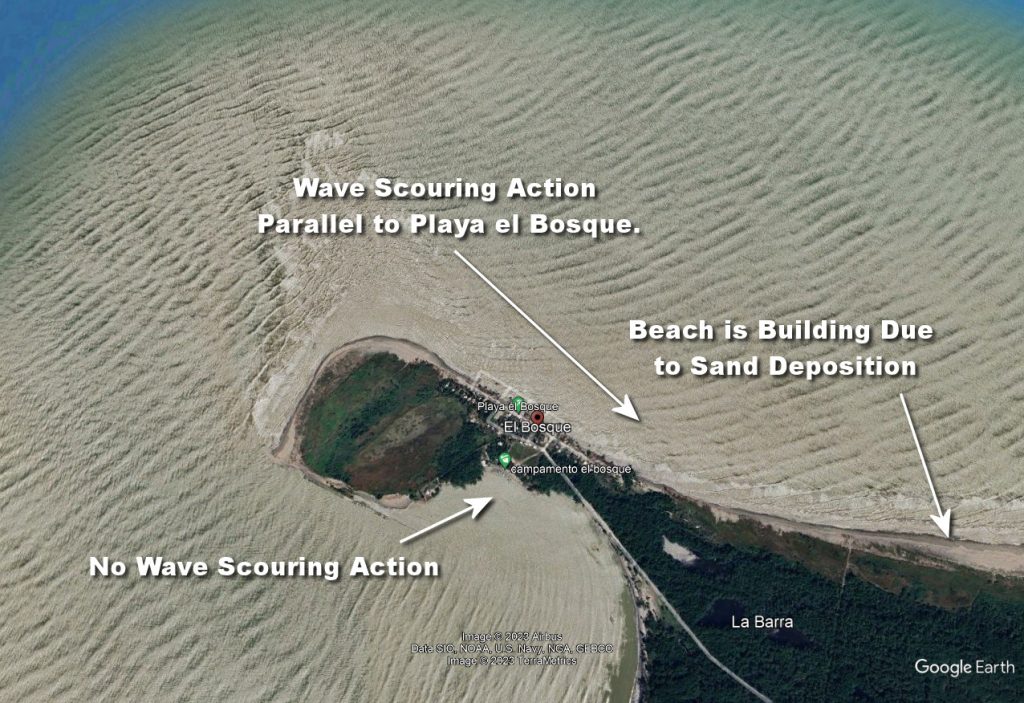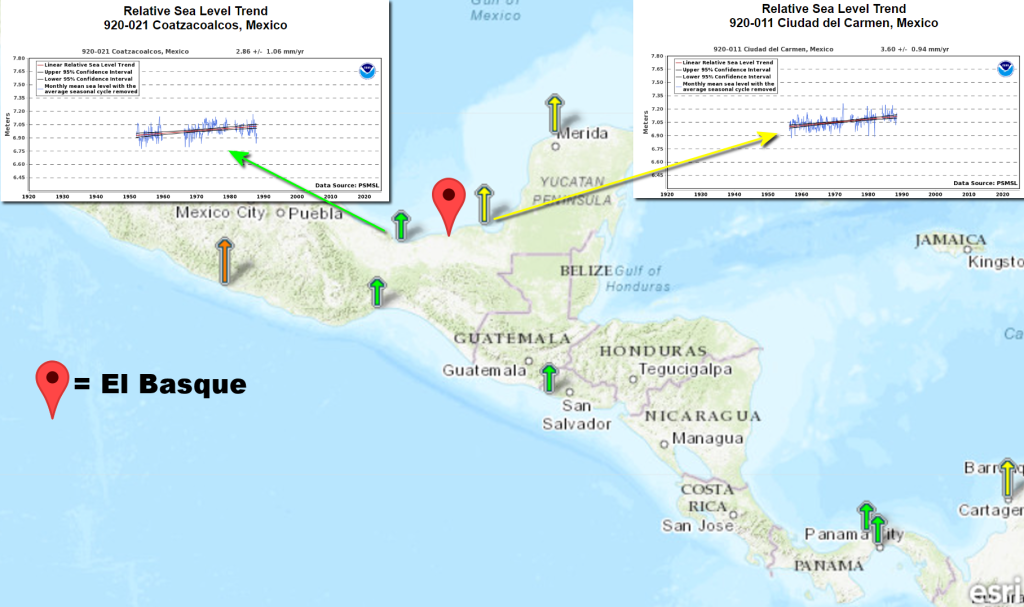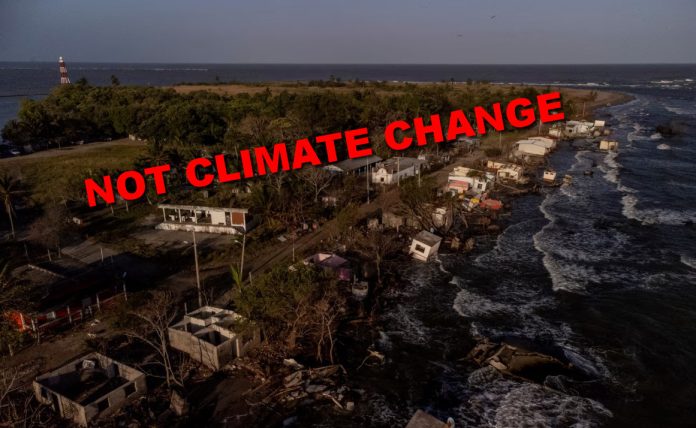Image: The shoreline of El Bosque, showing houses destroyed by the eroding beach. Source: The Guardian/Gustavo Graf
In an October 24 Amnesty International News article, titled “We may be the first people displaced by climate change in Mexico, but we won’t be the last,” Guadalupe Cobos Pacheco claims that the tiny seaside fishing town he lives in, the El Bosque community in Tabasco, Mexico, is being overwhelmed by sea level rise driven by climate change. Data and historical imagery show this to be false. Other factors, such as choice of building location, prevailing ocean waves, and beach erosion are the cause.
Pacheco writes:
Before climate change, our daily routine was to go fishing and sell our produce. Like any community, we celebrated our customs and traditions. We celebrated important dates such as Christmas, New Year or the Day of the Dead. We heard about climate change on television, but we never thought it would destroy our community. We could sleep easy.
Since 2019, our lives have completely changed. Now our lives revolve around climate change. That year, a storm swept away the first row of homes, and rising sea levels, coastal erosion, and northerly winds have continued to destroy our community. Our only option now is to leave.
The most important point that Pacheco fails to recognize in his own writing is that one storm in 2019 is not the same as climate change. The World Meteorological Organization clearly defines that single weather events are not the same as climate change. There has been no long-term trend in greater numbers of or more severe storms striking this area during the past few decades that would suggest climate change was causing an issue.
Rather than climate change, Pacheco should blame simple beach mechanics for what is happening at the El Bosque community in Tabasco.
El Bosque is built on a peninsular sand bar, jutting into the ocean. Sandbars are formed from the combination of erosion and deposition processes, which are driven by wave action. That particular section of beach is steeply sloping into the sea, and it is well known that a steeply sloping shore will cause waves to break closer to shore, causing more erosion than on a gently sloping shore.
The storm in 2019 started the process of beach scouring, making the slope steeper, and accelerating the process.
An article in The Guardian illustrates the process that has happened since:
But since 2019, residents of El Bosque say a series of severe weather fronts, bringing heavy rain and powerful winds, have been eroding the shoreline. As the ocean has encroached, more than 60 homes in the village have been destroyed by the waves.
With a steeper beach slope, additional storms have more impact than they have had in the past. Since 2019, the shoreline has eroded faster. This is illustrated in Figures 1 and 2 below.
Figure 1, from a 2015 study, published in Boletín de la Sociedad Geológica, titled, “Mexicana Cambios morfológicos y sedimentológicos en playas del sur del Golfo de México y del Caribe noroeste,” shows how that particular section of beach where El Bosque was built has both expanded and eroded at different periods of time.

In Figure 1, note that on the south side of the peninsula, in the cove area, there is essentially no beach erosion, or significant growth through deposition, over time. This suggests that the prevailing wave action comes from the north, driven by weather systems.
Figure 2, from Google Earth, shows satellite imagery from February 2023 of the peninsular sand bar that El Bosque is built on. Note that in this image, strong waves are present coming from the northwest, this creates a wave scouring action that rips sand from the beach and deposits it elsewhere, in the direction of the waves. The beach to the far right, as illustrated in Figure 1, is actually growing, as indicated by the black line beach profile.

This is not climate change, climate change does not reach out to affect a small section of beach, shrinking one part, and building up another less than one mile away. This is simple and well-known beach mechanics of sand bars. It is established by ocean science that sandbars shift regularly over time.
The article also claims, “Rising sea levels caused by climate change have swept away more than 200 meters of coastline here, destroying more than 50 homes.”
Examining the data for sea level rise in the region, one finds no supporting evidence for that claim. In fact, there is no data available for the last 30 years at all from the two closest tide gauges at Ciudad del Carmen or Coatzacoalcos, Mexico. This is shown in Figure 3 below:

Without such data, it is impossible to honestly claim that sea levels are rising, much less rising at an unusual, global warming accelerated rate.
Looking at the latest available data, however, one can, playing Devil’s advocate, assume that the trends indicated at those two stations has continued rising unchanged since the last readings were available around 1988. The National Oceanic and Atmospheric Administration (NOAA) Tides and Currents website has this to say about the data at each station:
Ciudad del Carmen, Mexico: The relative sea level trend is 3.6 millimeters/year with a 95% confidence interval of +/- 0.94 mm/yr based on monthly mean sea level data from 1956 to 1988 which is equivalent to a change of 1.18 feet in 100 years.
Coatzacoalcos, Mexico: The relative sea level trend is 2.86 millimeters/year with a 95% confidence interval of +/- 1.06 mm/yr based on monthly mean sea level data from 1952 to 1987 which is equivalent to a change of 0.94 feet in 100 years.
The 100 year sea level rise between the two stations averages out to 1.06 feet per century (1.18 + 0.94 /2 ). For the 35 years since the last data available in 1988, that would be 0.37 feet or 4.45 inches. This is near or well below the average sea level rise that the IPCC projects to occur over the 21st century, so unless the rates of rise have increased dramatically, climate change isn’t causing much sea level rise at El Bosque. In addition, the small estimated amount of rise certainly cannot account for the beach erosion and loss that has happened there. It is far below the average daily tidal variation, which can vary as much as 1.77 feet in a single day according to tide tables for Ciudad del Carmen.
Clearly, the claims of climate driven sea level rise are unsupportable. The likely cause of the recent sandbar erosion is the aforementioned wave driven beach erosion, triggered by the 2019 storm which increased the slope of the beach, making it even more susceptible to ocean storms and waves.
Tragically, the homes of El Bosque were built on the edge of the shifting sandbar. The residents were likely unaware of the dangers of building on sands which shift with such ease and passing storms. With the mainstream media blaming climate change for every natural event that can be portrayed as out of the ordinary, it unsurprising Pacheco has mistakenly blamed his village’s plight on climate change. There are several stories in the media recently making the same claim.
The incompetence of the media and NGOs, like Amnesty International News, in doing even the most basic investigation is disturbing and misleading.




















Another example of misrepresentation of a weather event and attributing it to the buzzword “climate change”! You say it often enough then it must be true! Every extreme weather event is always just that an extreme weather event! The beach erosion and rebuilding of sand is just a geological phenomenon that occurs! That’s something that occurs regularly as seaside conditions always are in motion and never remain static!